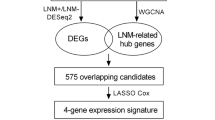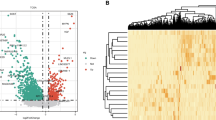Abstract
Purpose
Existing biomarkers for diagnosing and predicting metastasis of lung adenocarcinoma (LUAD) may not meet the demands of clinical practice. Risk prediction models with multiple markers may provide better prognostic factors for accurate diagnosis and prediction of metastatic LUAD.
Methods
An animal model of LUAD metastasis was constructed using CRISPR technology, and genes related to LUAD metastasis were screened by mRNA sequencing of normal and metastatic tissues. The immune characteristics of different subtypes were analyzed, and differentially expressed genes were subjected to survival and Cox regression analyses to identify the specific genes involved in metastasis for constructing a prediction model. The biological function of RFLNA was verified by analyzing CCK-8, migration, invasion, and apoptosis in LUAD cell lines.
Results
We identified 108 differentially expressed genes related to metastasis and classified LUAD samples into two subtypes according to gene expression. Subsequently, a prediction model composed of eight metastasis-related genes (RHOBTB2, KIAA1524, CENPW, DEPDC1, RFLNA, COL7A1, MMP12, and HOXB9) was constructed. The areas under the curves of the logistic regression and neural network were 0.946 and 0.856, respectively. The model effectively classified patients into low- and high-risk groups. The low-risk group had a better prognosis in both the training and test cohorts, indicating that the prediction model had good diagnostic and predictive power. Upregulation of RFLNA successfully promoted cell proliferation, migration, invasion, and attenuated apoptosis, suggesting that RFLNA plays a role in promoting LUAD development and metastasis.
Conclusion
The model has important diagnostic and prognostic value for metastatic LUAD and may be useful in clinical applications.









Similar content being viewed by others
Data availability statement
Data relevant to this study are available from the corresponding authors upon reasonable request.
References
Allemani C, Matsuda T, Di Carlo V, Harewood R, Matz M, Niksic M, Bonaventure A, Valkov M, Johnson CJ, Estève J, Ogunbiyi OJ, Silva GA, Chen WQ, Eser S, Engholm G, Stiller CA, Monnereau A, Woods RR, Visser O, Lim GH, Aitken J, Weir HK, Coleman MP (2018) Global Surveillance of Trends in Cancer Survival 2000–14 (Concord-3): Analysis of Individual Records for 37 513 025 Patients Diagnosed with One of 18 Cancers from 322 Population-Based Registries in 71 Countries. Lancet 391(10125):1023–1075. https://doi.org/10.1016/S0140-6736(17)33326-3
Calvayrac O, Pradines A, Pons E, Mazieres J, Guibert N (2017) Molecular biomarkers for lung adenocarcinoma. Eur Respir J 49(4):1601734. https://doi.org/10.1183/13993003.01734-2016
Cha G, Xu J, Xu X, Li B, Lu S, Nanding A, Hu S, Liu S (2017) High expression of CIP2A protein is associated with tumor aggressiveness in stage I-III NSCLC and correlates with poor prognosis. Onco Targets Ther 10:5907–5914. https://doi.org/10.2147/OTT.S148250
Chen YL, Ge GJ, Qi C, Wang H, Wang HL, Li LY, Li GH, Xia LQ (2018) A five-gene signature may predict sunitinib sensitivity and serve as prognostic biomarkers for renal cell carcinoma. J Cell Physiol 233(10):6649–6660. https://doi.org/10.1002/jcp.26441
Dolly SO, Collins DC, Sundar R, Popat S, Yap TA (2017) Advances in the development of molecularly targeted agents in non-small-cell lung cancer. Drugs 77(8):813–827. https://doi.org/10.1007/s40265-017-0732-2
Dong W, Meng L, Shen HC, Du JJ (2012) Loss of DBC2 expression is an early and progressive event in the development of lung adenocarcinoma. Asian Pac J Cancer Prev 13(5):2021–2023. https://doi.org/10.7314/apjcp.2012.13.5.2021
Ella E, Harel Y, Abraham M, Wald H, Benny O, Karsch-Bluman A, Vincent D, Laurent D, Amir G, Izhar U, Shapira OM, Yoon D, Lee HS, Sugarbaker DJ, Burt B, Peled A, Wald O (2018) Matrix metalloproteinase 12 promotes tumor propagation in the lung. J Thorac Cardiovasc Surg 155(5):2164-2175 e2161. https://doi.org/10.1016/j.jtcvs.2017.11.110
He D, Wang D, Lu P, Yang N, Xue Z, Zhu X, Zhang P, Fan G (2021) Single-cell RNA sequencing reveals heterogeneous tumor and immune cell populations in early-stage lung adenocarcinomas harboring EGFR mutations. Oncogene 40(2):355–368. https://doi.org/10.1038/s41388-020-01528-0
Hu F, Zhou Y, Wang Q, Yang Z, Shi Y, Chi Q (2020) Gene expression classification of lung adenocarcinoma into molecular subtypes. IEEE/ACM Trans Comput Biol Bioinform 17(4):1187–1197. https://doi.org/10.1109/TCBB.2019.2905553
Huang J, Li J, Zheng S, Lu Z, Che Y, Mao S, Lei Y, Zang R, Liu C, Wang X, Fang L, Sun N, He J (2020) Tumor microenvironment characterization identifies two lung adenocarcinoma subtypes with specific immune and metabolic state. Cancer Sci 111(6):1876–1886. https://doi.org/10.1111/cas.14390
Jiang X, Yan Q, Xie L, Xu S, Jiang K, Huang J, Wen Y, Yan Y, Zheng J, Tang S, Nie K, Zheng Z, Pan J, Liu P, Huang Y, Yan X, Zou Y, Chen X, Liu F, Li P, Zhuang K (2021) Construction and validation of a ferroptosis-related prognostic model for gastric cancer. J Oncol 2021:6635526. https://doi.org/10.1155/2021/6635526
Kaowinn S, Kaewpiboon C, Kim JE, Lee MR, Hwang DY, Choi YW, Kim HW, Park JK, Song KM, Lee NH, Maeng JS, Chung YH (2018) N-Benzyl-N-methyl-dodecan-1-amine, a novel compound from garlic, exerts anti-cancer effects on human A549 lung cancer cells overexpressing cancer upregulated gene (CUG)2. Eur J Pharmacol 841:19–27. https://doi.org/10.1016/j.ejphar.2018.09.035
Kaowinn S, Yawut N, Koh SS, Chung YH (2019) Cancer upregulated gene (CUG)2 elevates YAP1 expression, leading to enhancement of epithelial-mesenchymal transition in human lung cancer cells. Biochem Biophys Res Commun 511(1):122–128. https://doi.org/10.1016/j.bbrc.2019.02.036
Kim MO, Choe MH, Yoon YN, Ahn J, Yoo M, Jung KY, An S, Hwang SG, Oh JS, Kim JS (2017) Antihelminthic drug niclosamide inhibits CIP2A and reactivates tumor suppressor protein phosphatase 2A in non-small cell lung cancer cells. Biochem Pharmacol 144:78–89. https://doi.org/10.1016/j.bcp.2017.08.009
Li H, Tong L, Tao H, Liu Z (2020) Genome-wide analysis of the hypoxia-related DNA methylation-driven genes in lung adenocarcinoma progression. Biosci Rep.
Lin W, Chen Y, Wu B, Chen Y, Li Z (2021) Identification of the pyroptosisrelated prognostic gene signature and the associated regulation axis in lung adenocarcinoma. Cell Death Discov 7(1):161. https://doi.org/10.1038/s41420-021-00557-2
Liu L, Shi M, Wang Z, Lu H, Li C, Tao Y, Chen X, Zhao J (2018) A molecular and staging model predicts survival in patients with resected non-small cell lung cancer. BMC Cancer 18(1):966. https://doi.org/10.1186/s12885-018-4881-9
Lu L, Liu LP, Zhao QQ, Gui R, Zhao QY (2021) Identification of a ferroptosis-related LncRNA signature as a novel prognosis model for lung adenocarcinoma. Front Oncol. https://doi.org/10.3389/fonc.2021.675545
Lv FZ, Wang JL, Wu Y, Chen HF, Shen XY (2015) Knockdown of MMP12 inhibits the growth and invasion of lung adenocarcinoma cells. Int J Immunopathol Pharmacol 28(1):77–84. https://doi.org/10.1177/0394632015572557
Molina JR, Yang P, Cassivi SD, Schild SE, Adjei AA (2008) Non-small cell lung cancer: epidemiology, risk factors, treatment, and survivorship. Mayo Clin Proc 83(5):584–594. https://doi.org/10.4065/83.5.584
Mu L, Ding K, Tu R, Yang W (2021) Identification of 4 immune cells and a 5-lncRNA risk signature with prognosis for early-stage lung adenocarcinoma. J Transl Med 19(1):127. https://doi.org/10.1186/s12967-021-02800-x
Roys A, Chang X, Liu Y, Xu X, Wu Y, Zuo D (2019) Resistance mechanisms and potent-targeted therapies of ROS1-positive lung cancer. Cancer Chemother Pharmacol 84(4):679–688. https://doi.org/10.1007/s00280-019-03902-6
Rudin CM, Brambilla E, Faivre-Finn C, Sage J (2021) Small-cell lung cancer. Nat Rev Dis Primers 7(1):3. https://doi.org/10.1038/s41572-020-00235-0
Shi X, Li R, Dong X, Chen AM, Liu X, Lu D, Feng S, Wang H, Cai K (2020) IRGS: an immune-related gene classifier for lung adenocarcinoma prognosis. J Transl Med 18(1):55. https://doi.org/10.1186/s12967-020-02233-y
Siegel RL, Miller KD, Fuchs HE, Jemal A (2022) Cancer statistics, 2022. CA Cancer J Clin 72(1):7–33. https://doi.org/10.3322/caac.21708
Smith RA, Manassaram-Baptiste D, Brooks D, Doroshenk M, Fedewa S, Saslow D, Brawley OW, Wender R (2015) Cancer screening in the United States, 2015: a review of current American cancer society guidelines and current issues in cancer screening. CA Cancer J Clin 65(1):30–54. https://doi.org/10.3322/caac.21261
Spella M, Stathopoulos GT (2021) Immune resistance in lung adenocarcinoma. Cancers (basel) 13(3):384. https://doi.org/10.3390/cancers13030384
Wang CJ, Yang D, Luo YW (2015) Rhobtb2 (Dbc2) functions as a multifunctional tumor suppressor in thyroid cancer cells via mitochondrial apoptotic pathway. Int J Clin Exp Med 8(4):5954–5958
Wang Q, Li A, Jin J, Huang G (2017) Targeted interfering DEP domain containing 1 protein induces apoptosis in A549 lung adenocarcinoma cells through the NF-kappaB signaling pathway. Onco Targets Ther 10:4443–4454. https://doi.org/10.2147/OTT.S142244
Wang J, Chu Y, Li J, Wang T, Sun L, Wang P, Fang X, Zeng F, Wang J, Zeng F (2019) The clinical value of carcinoembryonic antigen for tumor metastasis assessment in lung cancer. PeerJ 7:e7433. https://doi.org/10.7717/peerj.7433
Wang W, Li A, Han X, Wang Q, Guo J, Wu Y, Wang C, Huang G (2020) DEPDC1 up-regulates RAS expression to inhibit autophagy in lung adenocarcinoma cells. J Cell Mol Med 24(22):13303–13313. https://doi.org/10.1111/jcmm.15947
Wang M, Herbst RS, Boshoff C (2021) Toward personalized treatment approaches for non-small-cell lung cancer. Nat Med 27(8):1345–1356. https://doi.org/10.1038/s41591-021-01450-2
Ye G, Liu Y, Huang L, Zhang C, Sheng Y, Wu B, Wu C, Qi Y (2021) miRNA-218/FANCI is associated with metastasis and poor prognosis in lung adenocarcinoma: a bioinformatics analysis. Ann Transl Med 9(16):1298–1298. https://doi.org/10.21037/atm-21-3823
Zhan J, Wang P, Niu M, Wang Y, Zhu X, Guo Y, Zhang H (2015) High expression of transcriptional factor HoxB9 predicts poor prognosis in patients with lung adenocarcinoma. Histopathology 66(7):955–965. https://doi.org/10.1111/his.12585
Zhang M, Qi W, Sun Y, Jiang Y, Liu X, Hong N (2018) Screening for lung cancer using sub-millisievert chest Ct with iterative reconstruction algorithm: image quality and nodule detectability. Br J Radiol 91(1090):20170658. https://doi.org/10.1259/bjr.20170658
Zhang L, Zhang Z, Yu Z (2019) Identification of a novel glycolysis-related gene signature for predicting metastasis and survival in patients with lung adenocarcinoma. J Transl Med 17(1):423. https://doi.org/10.1186/s12967-019-02173-2
Zhang W, Yao S, Huang H, Zhou H, Zhou H, Wei Q, Bian T, Sun H, Li X, Zhang J, Liu Y (2021) Molecular subtypes based on ferroptosis-related genes and tumor microenvironment infiltration characterization in lung adenocarcinoma. Oncoimmunology 10(1):1959977. https://doi.org/10.1080/2162402X.2021.1959977
Zhao Y, Varn FS, Cai G, Xiao F, Amos CI, Cheng C (2018) A P53-deficiency gene signature predicts recurrence risk of patients with early-stage lung adenocarcinoma. Cancer Epidemiol Biomarkers Prev 27(1):86–95. https://doi.org/10.1158/1055-9965.EPI-17-0478
Zhao Y, Gao Y, Xu X, Zhou J, Wang H (2021) Multi-omics analysis of genomics, epigenomics and transcriptomics for molecular subtypes and core genes for lung adenocarcinoma. BMC Cancer 21(1):257. https://doi.org/10.1186/s12885-021-07888-4
Funding
This work was supported by Wenzhou Municipal Science and Technology Bureau of China (Y20220127, Y20190461), Zhejiang Provincial Natural Science Foundation of China (LQ22H200003, LY19H200002), the Fundamental Scientific Research Fees of Wenzhou Medical University (KYYW2021026), the Key Laboratory of Clinical Laboratory Diagnosis and Translational Research of Zhejiang Province (2022E10022), the National Natural Science Foundation of China (81672088), and Zhejiang Provincial Research Center for Cancer Intelligent Diagnosis and Molecular Technology (JBZX-202003). All the authors declare that they have no further financial or non-financial conflicts of interest in this research.
Author information
Authors and Affiliations
Contributions
YW, JP, and JC conceived and designed the study. FS, LL, CL, and XH performed the experiments and analyzed the data. YY, MZ, and KH prepared figures and/or tables. FS and YW drafted and revised of the manuscript. All authors contributed to the article and approved the submitted version.
Corresponding authors
Ethics declarations
Conflict of interest
The authors have no relevant financial or non-financial interests to disclose.
Ethics approval and consent to participate
All animal procedures were approved by the Experimental Animal Ethics Committee of the First Affiliated Hospital of Wenzhou Medical University (WYYY-AEC-2021–310).
Consent for publication
All authors were read the final version and agreed on the publication.
Additional information
Publisher's Note
Springer Nature remains neutral with regard to jurisdictional claims in published maps and institutional affiliations.
Supplementary Information
Below is the link to the electronic supplementary material.
Rights and permissions
Springer Nature or its licensor (e.g. a society or other partner) holds exclusive rights to this article under a publishing agreement with the author(s) or other rightsholder(s); author self-archiving of the accepted manuscript version of this article is solely governed by the terms of such publishing agreement and applicable law.
About this article
Cite this article
Shao, F., Ling, L., Li, C. et al. Establishing a metastasis-related diagnosis and prognosis model for lung adenocarcinoma through CRISPR library and TCGA database. J Cancer Res Clin Oncol 149, 885–899 (2023). https://doi.org/10.1007/s00432-022-04495-z
Received:
Accepted:
Published:
Issue Date:
DOI: https://doi.org/10.1007/s00432-022-04495-z




